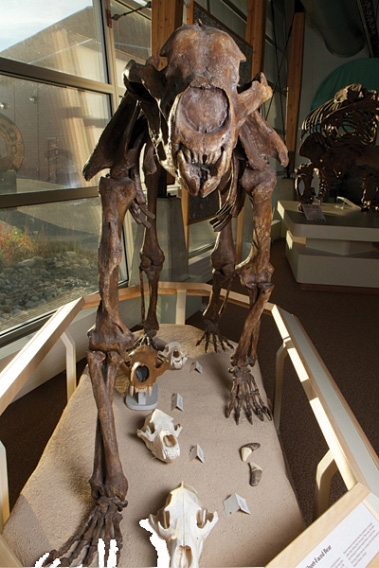Giant Short-faced Bear
Ice age short-faced bears were the largest mammalian land carnivore to ever live in North America. These bears were nearly 1.5 metres high when walking normally, but stood about 3.4 metres tall when on their hind legs. They could have had a vertical reach of more than 4.3 metres. This is about one and a half times the size of a present-day Kodiak grizzly bear!
Given their huge size and taste for meat, the short-faced bear has a surprising evolutionary history. Their closest living relative is the spectacled bear (Tremarctos ornatus), which lives among the trees in the mountainous regions of western and northern South America. Spectacled bears have short, broad faces like the ice aged short-faced bear but are nearly entirely herbivorous, preferring leaves, fruit and other vegetation.
Yukon's Largest Hypercarnivore?

on display at YBIC.
There is some debate regarding the diets and behaviour of the ice age short-faced bear. Given its huge body stature, large molars and canine teeth, it is tempting to view them as menacing predators. However, investigation of their fossil skeletons reveals a much different picture. A prominent feature of the short-faced bear is their remarkably long, thin limb bones and feet that supported a heavy torso. These limbs were adapted for efficient long-distance pacing, rather than the explosive acceleration and high speed pursuits typical of other large predators, like lions. The limbs and feet of a short-faced bear could not support their large bodies for the rapid acceleration or sudden changes in direction necessary to take down a fleeing bison or horse.
The cranium also provides some clues to short-faced bear behaviour. The nasal opening is very large, suggesting they had a pronounced sense of smell. This, combined with their long limbs, point to the short-faced bear as a solitary, wide-ranging scavenger of carcasses. Rather than killing on their own, the short-faced bear would probably smell the scent of meat in the wind, follow it to the carcass, chase off the lions or wolves, and dine on the leftovers.
Their large cheek teeth were probably effective at cracking long bones for their marrow and sharp fangs could deflesh the carcass. The chemistry of short-faced bear fossil bones from Yukon and Alaska indicate a diet nearly completely composed of meat.
This model of the short-faced bear's hyper-carnivorous scavenging, however, is not universally accepted. Some scientists have recently suggested that the short-faced bear was neither particularily long-limbed nor short-faced, and propose that they were omnivorous, like most bears are today. More evidence, including new short-faced bear bones found in Yukon will be needed to help solve this question.
Want to learn more? Check out the Beringian Research Notes on the giant short-faced bear.

